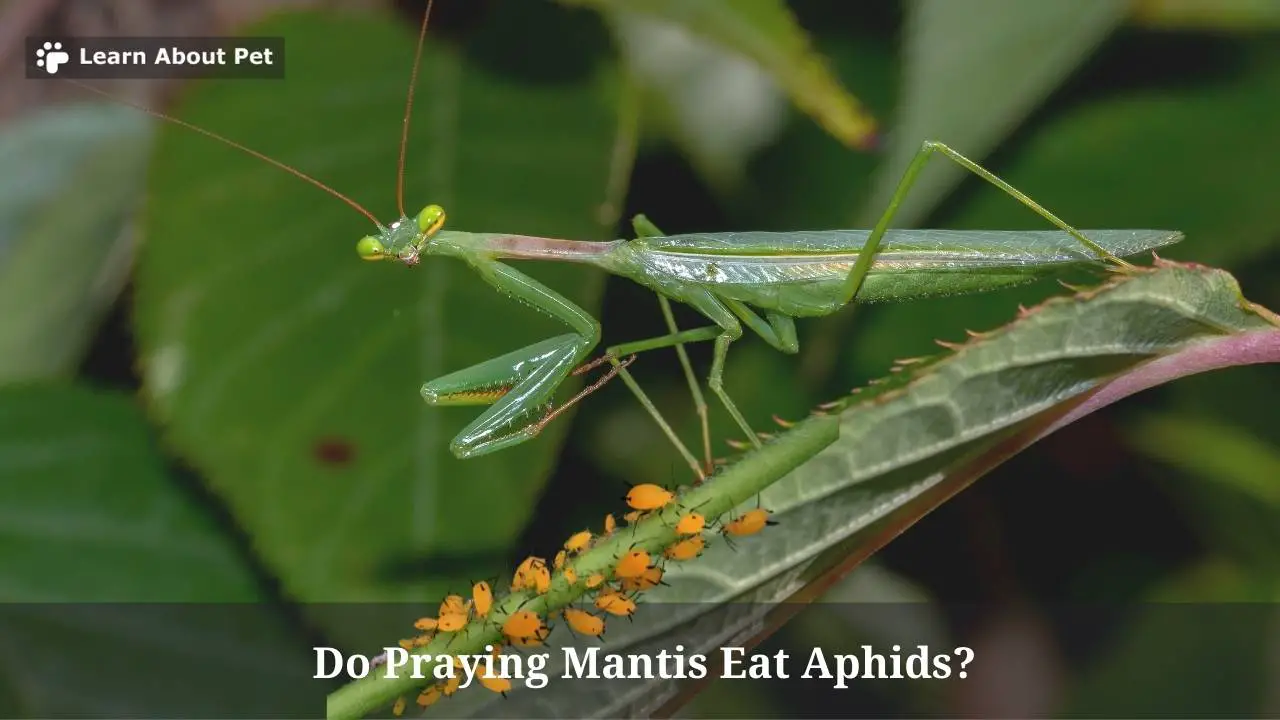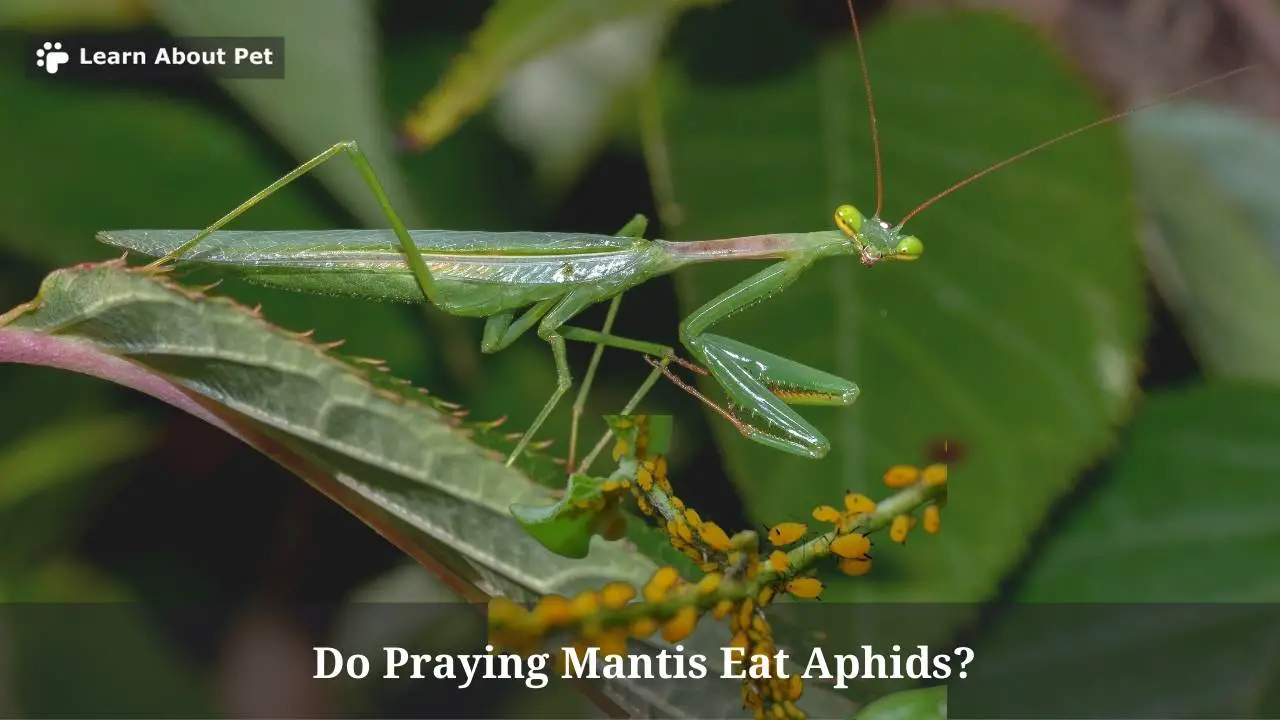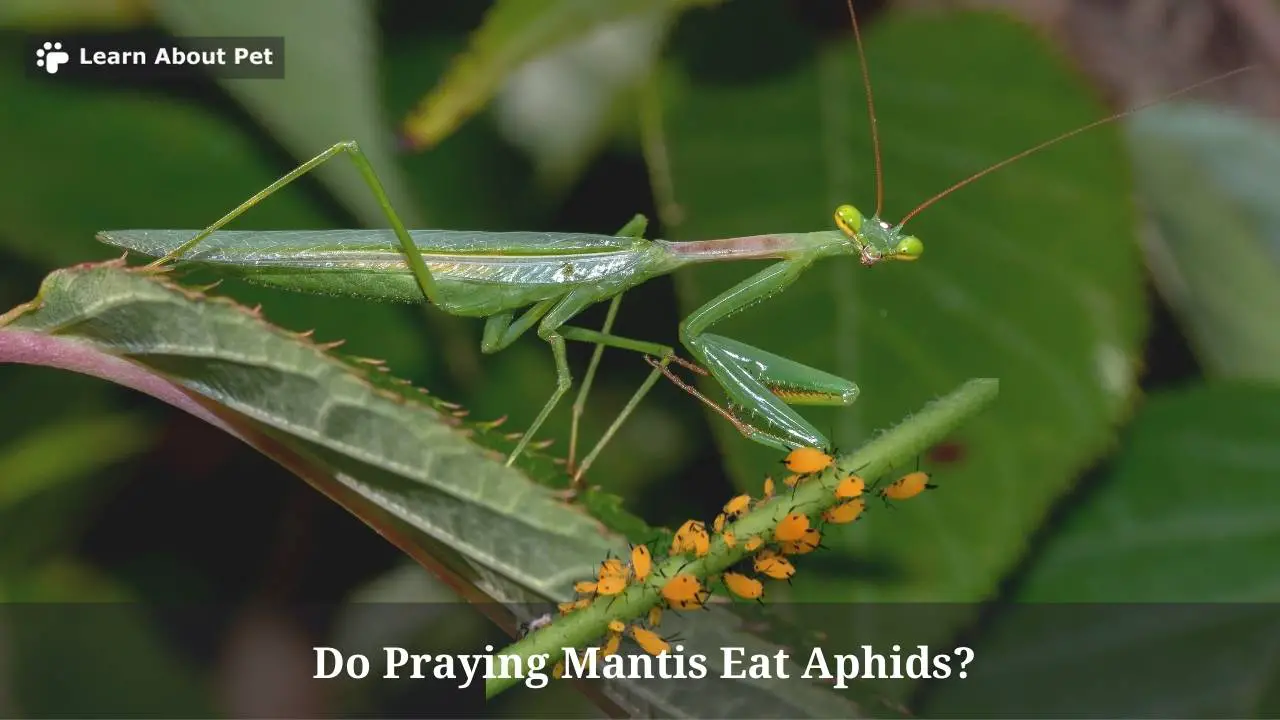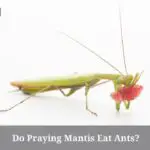Owners of pet praying mantises often express interest in knowing whether the mantises can eat aphids. Gardeners and farmers too may sometimes want to know if praying mantis can eat the aphids that destroy their plants. Read on, to find out whether praying mantis can eat aphids.
Do praying mantis eat aphids? Yes, praying mantis do eat aphids. If you give your praying mantis live aphids, it will usually go ahead to eat them. And if you find a praying mantis in a garden or farm with an aphid infestation problem, the mantis may help in culling the aphids.
In nature (that is, in the wild) aphids tend to be among the most commonly eaten foods by praying mantises.

However, people who are still new to praying mantises may doubt their capability to kill ‘hardy’ insects like aphids. That is why you often find folks asking whether the mantises can really kill aphids. We may as well start with that question.
Do Praying Mantis Kill Aphids?
Yes, praying mantises have the capability to kill aphids. And the mantises do indeed often kill the aphids, when they encounter them.
While the mantises may not be able to run after the aphids, they are always able to ambush them. And once the aphids fall into the praying mantis ambushes, it tends to be just a matter of minutes before the mantises kill them.
Do Praying Mantis Eat Aphids?
Yes, praying mantis do eat aphids.
Going by the frequency with which mantises eat aphids (even when other insects are available), it is fair to say that the aphids are a favorite food for the mantises.
Indeed, if you ask most people what pest do praying mantis eat, they will tend to mention aphids. This only goes to show the extent to which people have come to associate praying mantises with eating aphids.
So, how exactly do praying mantis eat aphids?
All that an aphid has to do is fall into a praying mantis’ ambush. This is something the aphid often does easily: as the praying mantis’ camouflage tends to fool the aphid.
Once the aphid falls into the praying mantis’ ambush, the mantis will wait until it comes within grasping distance. Then at that point, the mantis just stretches its front limb, catches the aphid, and eats it.
Do Baby Praying Mantis Eat Aphids?
Aphids tend to be soft enough for baby praying mantises to eat. In fact, when praying mantises start hunting as babies, some of their first target prey insects tend to be aphids.
So baby praying mantises do eat aphids.
Aphids, alongside mosquitos and leafhoppers are among the main staples for baby praying mantises. That is before the baby mantises harden up, to a level of being able to eat tougher prey such as beetles and crickets.
How Does Praying Mantis Eat Aphids?
The primary organs through which praying mantises eat aphids are the mandibles.
Thus the praying mantis grasps the aphid with its forelimb, then brings it to its mouthpart for ingestion.
Prior to this, the aphid will have fallen into the praying mantis’ ambush. The praying mantis will have proceeded to clutch the aphid so tightly (with its spiny forelimb) that the aphid gets immobilized.
It is after this point then that the mantis will devour the aphid, using its rather impressive mandibles.
Which Aphids Do Praying Mantis Eat?
In any given garden, farm or bush land, you will find some aphids that are alive and some that have died.
The question before us is which of those two types of aphids (live aphids and dead aphids) praying mantises eat. Let’s find out.
Do Praying Mantis Eat Live Aphids?
Yes, praying mantis do eat live aphids.
Usually, all that the praying mantises do is lie patiently in areas that are frequented by aphids. Soon or later, the aphids show up. But the aphids are unable to detect the presence of the mantises, which are well camouflaged.
Unable to detect the presence of the camouflaged mantises, the aphids walk right into the mantises’ clutches. Then they are eaten.
And while that approach to hunting may seem tedious, it is what the praying mantises prefer. In fact, the mantises won’t eat any aphid, unless they happen to have found it alive, and gone through the process of hunting it down.

Do Praying Mantis Eat Dead Aphids?
No, praying mantis don’t eat dead aphids.
As noted earlier, for a praying mantis to eat an aphid, that has to be an aphid which the mantis found alive. It has to be an aphid that the mantis hunted down: not one that the mantis would have found already dead.
Any serious tutorial on how to feed aphids to praying mantis will start with a disclaimer that you can only use live aphids.
Consequently , if you collect dead aphids and present them to your praying mantis, the mantis will outright spurn them.
How Often Will Praying Mantis Eat Aphids?
If an adult mantis is feeding on aphids exclusively (or almost exclusively), the feeding frequency may be twice per week.
But if it’s a baby or growing mantis feeding on aphids exclusively (or almost exclusively), feeding frequency may be every other day.
Can praying mantis eat aphids daily? The answer is that having a mantis feed on aphids daily may not be proper at all.
Even a baby or growing mantis should only be eating every other day: not daily. And for a mature adult mantis, feeding frequency should be like once per 3-4 days, or roughly twice per week.
Thus the notion of feeding a mantis daily (on aphids or anything else) may be misplaced.
As for whether the mantis can eat the aphids exclusively, this too may not be proper. Ideally, the mantis should be feeding on a variety of things, unless only one type of food is obtainable.
While keeping a pet mantis, you should try to replicate its natural (wild) conditions as well as possible. And that includes giving it a variety of things to eat, as it would be having in the wild.
How Many Aphids Can A Praying Mantis Eat In A Day?
For small insects such as aphids, it is recommended to give an adult mantis up to 5 in a day. On the other hand, a mantis nymph eating such small insects would require roughly 2.
One may then ask, how much is too much aphids for a praying mantis? And the answer is that, when feeding a praying mantis, it is best not to go beyond 5 aphids. Actually for a mantis nymph, even 3 aphids in a day may be unmanageable.
Final Verdict – Do Praying Mantis Eat Aphids
Praying mantises do eat aphids. In fact, you are unlikely to find any list of insects that are eaten by praying mantises that excludes aphids.
When baby praying mantises first hatch, aphids (alongside other softer insects like mosquitoes and leafhoppers) tend to be their first prey. Then later they graduate to eating tougher insects like crickets and beetles.
Thus aphids are edible by praying mantises at almost all stages: from baby mantises to adult mantises.
While aphids are agile insects, praying mantises are nonetheless able to capture them by laying effective ambushes.
Once the aphids fall into the praying mantises’ arms, they get immobilized then eaten in very quick succession.

It is worth noting that praying mantises can only accept to eat aphids if they find the aphids alive. Dead aphids (or indeed any other dead insects) are not really viewed as edible food by mantises.
Thus if you keep a pet mantis, and you are thinking of feeding it on aphids, don’t collect dead aphids. The mantis won’t entertain the idea of eating such dead aphids, however well you present them.
But if a praying mantis is presented with aphids that are alive, and it is hungry, it can eat them.
As a pet lover, make sure to learn about pet more and give your pet mantis a good and comfortable life!

Welcome to Learn About Pet. My name is Rajkumar Ravichandran and I love all pets, travel, and amazing food. I write about my passion and personal experience caring for multiple pets in this blog! ❤️
Post Disclaimer
DISCLAIMER: THIS BLOG OR WEBSITE, "Learn About Pet", DOES NOT PROVIDE YOU WITH MEDICAL ADVICE AND IS NOT A SUBSTITUTE FOR MEDICAL ADVICE. ALWAYS GET IN TOUCH WITH YOUR PERSONAL VETERINARIAN AND USE INFORMATION HERE AS GENERAL ADVICE.
The information, including but not limited to, text, graphics, images and other material contained on this website are for informational purposes only. No material on this site is intended to be a substitute for professional veterinary advice, food recommendation, diagnosis, or treatment. Always seek the advice of your veterinarian or other qualified health care provider with any questions you may have regarding a medical condition or for pet food related questions.







